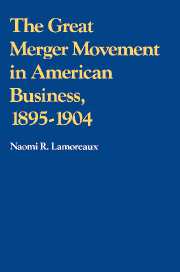Book contents
- Frontmatter
- Contents
- Acknowledgments
- List of tables and figures
- 1 Introduction
- 2 Product differentiation, mass production, and the urge to merge: competitive strategies and collusion in the late nineteenth century
- 3 High fixed costs and rapid expansion: a model of price warfare and two examples
- 4 Quantitative and qualitative evidence on the great merger movement
- 5 What changed? The impact of consolidations on competitive behavior
- 6 The great merger movement and antitrust policy
- 7 Conclusion
- Bibliographical essay
- Index
3 - High fixed costs and rapid expansion: a model of price warfare and two examples
Published online by Cambridge University Press: 01 April 2010
- Frontmatter
- Contents
- Acknowledgments
- List of tables and figures
- 1 Introduction
- 2 Product differentiation, mass production, and the urge to merge: competitive strategies and collusion in the late nineteenth century
- 3 High fixed costs and rapid expansion: a model of price warfare and two examples
- 4 Quantitative and qualitative evidence on the great merger movement
- 5 What changed? The impact of consolidations on competitive behavior
- 6 The great merger movement and antitrust policy
- 7 Conclusion
- Bibliographical essay
- Index
Summary
By the 1890s, then, there had developed in industries such as tin plate and newsprint a type of industrial structure significantly different from what had prevailed earlier in the century. Replacing the small firms, with their concern for product differentiation and price stability, were large, mass-production enterprises whose heavy capital investments gave rise to new forms of competitive behavior -an emphasis on “running full” and a neglect of product differentiation. Conventional notions notwithstanding, these mass-production industries were typically dominated neither by innovative entrepreneurs nor by ruthless robber barons. More often than not they were the preserve of a dozen or more large firms, all of which were equivalently equipped to compete for sales, none of which was able to secure an exclusive advantage for itself.
It is important to understand the relationship between this new type of industrial structure and the severe price competition of the 1890s. The purpose of this chapter is to develop a model that captures the essential characteristics of firms in these mass-production industries and then to trace the model's implications for competitive behavior.
A preliminary model
Imagine an industry populated by a small number of firms, say ten. In this hypothetical industry each firm possesses one and only one plant; all plants are identical in size and efficiency, and all produce the same homogeneous product. There are no barriers to prevent new firms from entering this industry, but otherwise no assumptions are made to ensure perfect competition. On the contrary, it is assumed that firms are large relative to the market, that they are interdependent and aware of this fact, and that each firm's price and output decisions directly affect those of its rivals.
- Type
- Chapter
- Information
- Publisher: Cambridge University PressPrint publication year: 1985
- 1
- Cited by



